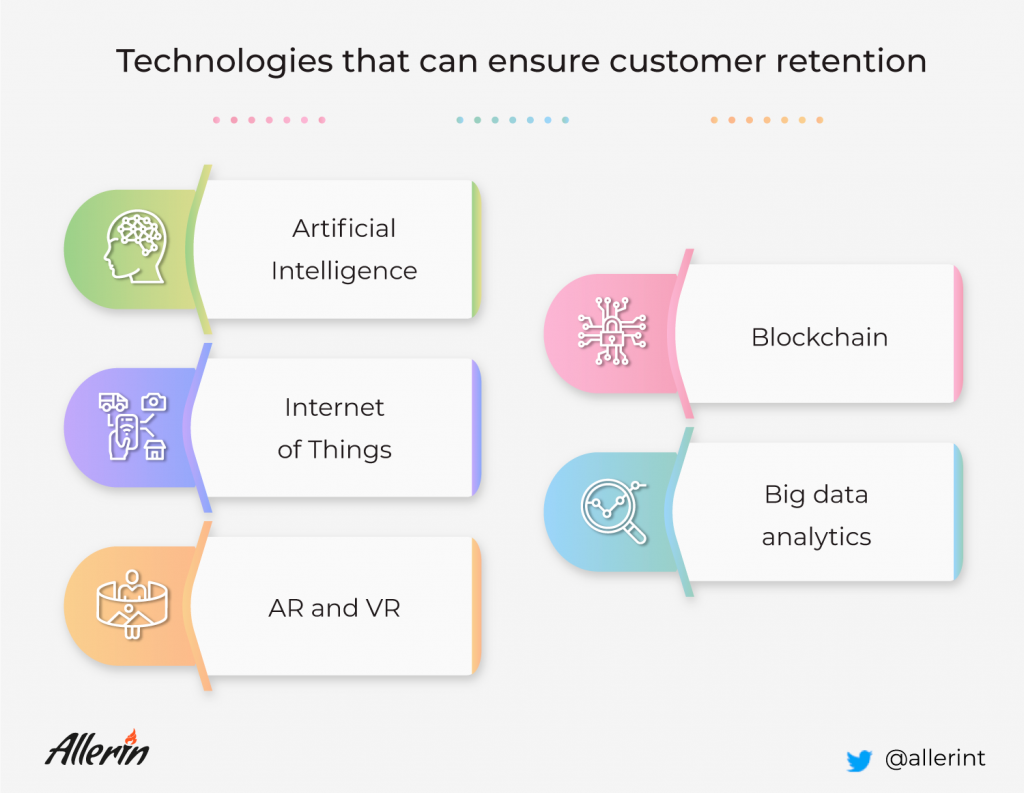Businesses are developing strategies to leverage customer retention technologies to enhance the customer experience to prevent losing them to competitors.
Competition in today’s business world is fierce. Every day we come across news about various startups. Businesses are applying various strategies to get a competitive advantage over others in this fierce competition. No matter what strategy they apply, the core focus of all of them will be attracting new customers and retaining the current ones. In fact, retaining existing customers is more valuable than acquiring new ones. That’s because retaining customers is cost-effective and provides greater profits. According to an infographic, acquiring new customers can be five times costlier than retaining them. The infographic also states that increasing retention by 5% can increase profit from 25% to 95%. Hence, businesses in today’s digital era are making various customer retention technologies a part of their strategies to retain more customers and generate more revenue.
The pillars for holding customer retention
Customer success: It is making sure that in the end, customers achieve or get exactly what they were looking for. For instance, if a customer is looking for any product, then he or she should not have to wait to get that product. The product has to be available in the inventory.
Customer support: Businesses should provide support to their customers right from the very first interaction to the time they are using their products or services. This includes ensuring quick and appropriate responses to customer queries, assisting them in using products or services, and improving relationships with enhanced engagement.
Personalization: One-size-fits-all is no more an option for businesses. Hence, they need to personalize their products, services, and communications based on their customers. Whether it is providing recommendations, sending advertisements, or communicating for any support, everything needs to be personalized based on customers’ preferences and needs.
Post-funnel marketing: Businesses should not end their services to customers once a sale is completed. They should continue to assist customers and listen to their voices as long as they use their products or services. Businesses can also create a loyalty program to offer perks and benefits to customers who are loyal to them.
Implementation of digital customer retention technologies
There are various digital technologies available that can help businesses to build the pillars which can hold the responsibility of customer retention. Some of these technologies are:

Artificial intelligence
AI-based chatbots can understand human language and respond to customers’ queries. They serve round the clock and reduce turnaround time. Chatbots eliminate the need for customers to wait for getting a response to their queries. AI systems can also analyze customers’ sentiments to detect their moods. Chatbots can analyze and detect specific words in the texts to analyze sentiments. Virtual assistants can analyze the vocal tone of customers to detect mood. And robots can use cameras to detect facial expressions and analyze sentiments based on them. AI systems can then respond to customers and engage with them based on their moods. For instance, if a customer is sad for some reason, robots can sing or dance for them to lighten up their mood. Companies can also integrate AI into their daily operations to provide personalized recommendations to customers. ML algorithms can categorize customers based on their preferences, location, and demographics. And based on the categorization, AI systems can provide personalized recommendations to customers.
Internet of Things
IoT devices collect real-time information that can be leveraged by businesses to provide enhanced services to customers. For instance, beacons can collect information about what product a customer has lifted from a shelf. And this information can help businesses to provide real-time personalized advertising and recommendations to the customer on a nearby LED screen or their smartphones. Suppose a customer lifts a shampoo sachet from a shelf, then a beacon can connect with his or her smartphone. An automated system can then send advertising about conditioner sachets to the customer on the smartphone. This can enhance engagement. And it also provides a sense of personalized experience to customers. Smart devices like smart-carts can make retail shops smarter by eliminating the need for waiting in queue for payments. Standing in a long queue after completing their purchase is hectic for consumers. And eliminating these queues can streamline their shopping experience. Smart-carts with embedded cameras can detect all the products purchased by customers. They can then auto-calculate the final billing amount. Customers can pay their bills digitally through smart-carts. This convenience can attract customers to return to your shops.
Virtual reality and augmented reality
Immersing customers in virtual and semi-virtual environments can be an effective way to engage them. AR and VR can enable people to get into the shoes of customers even before they buy a service or product from a company. And they can also provide customers a hands-on experience. For instance, a garment retailer can leverage AR and VR to create a virtual image of a customer wearing the purchased items. This can be majorly beneficial to the eCommerce business. Some people hold back from purchasing online as they cannot try purchased products. With AR and VR in place, eCommerce companies can enable consumers to try everything before they purchase, just like in retail stores. Bringing engagement in assistance for using a service or product can help retain customers. And what can be more engaging than having a human assistant every time a customer wants help. AR and VR can allow customers to immerse employees at their house if they are stuck while using any product or service. AR has the potential to take product manuals to an entirely new level. Product manuals are often boring except for a few images. But, AR can bring engagement to these boring manuals. Organizations can use marker-based AR to create an engaging product manual. They can point out every part of a product and display information about its function through texts, audio, and even videos.
Blockchain
Trust is vital to retain customers. Blockchain can bring transparency to the production and distribution line to enhance a brand’s trust among customers. Businesses can upload production details like raw materials and quantity of raw materials on a decentralized ledger. Customers can view how a product was manufactured, assembled, and distributed by accessing the ledger. Blockchain can also enable secure online transactions. Every record of an online transaction, along with billing details, can be uploaded on the blockchain platform. Since the details uploaded on the blockchain network cannot be altered, it can avoid any billing disputes between organizations and their customers.
Big data analytics
Businesses need to provide customers what they are looking for. This includes not just products and services, but also communications and offers. But sometimes companies might fail to cope with a sudden increase or decrease in demand for a particular product. And this can result in out-of-stock situations where customers cannot find the products they want. And if businesses cannot provide in-demand products to their loyal customers, then there are chances to lose them. To avoid any such situations, organizations can use big data analytics to improve the demand-supply cycle. Big data analytics can analyze massive amounts of historical data to understand what happened in the past and the reason behind it. Then it analyzes current data to understand market trends and what is currently changing. And then, based on both the information, big data analytics can predict future trends in the market and demand for specific products.
All the above mentioned technologies have the potential to increase customer retention by themselves. But when combined, they can ensure that businesses can easily retain most of their customers. For instance, AI can automate operations, IoT can bring in connectivity, and blockchain can secure transitions. Hence, when blockchain, IoT, and AI converge, they can form a secure, interconnected, and automated platform for revolutionizing the way we work. Hence, businesses should look forward to amalgamating various customer retention technologies to grow their customer base.




